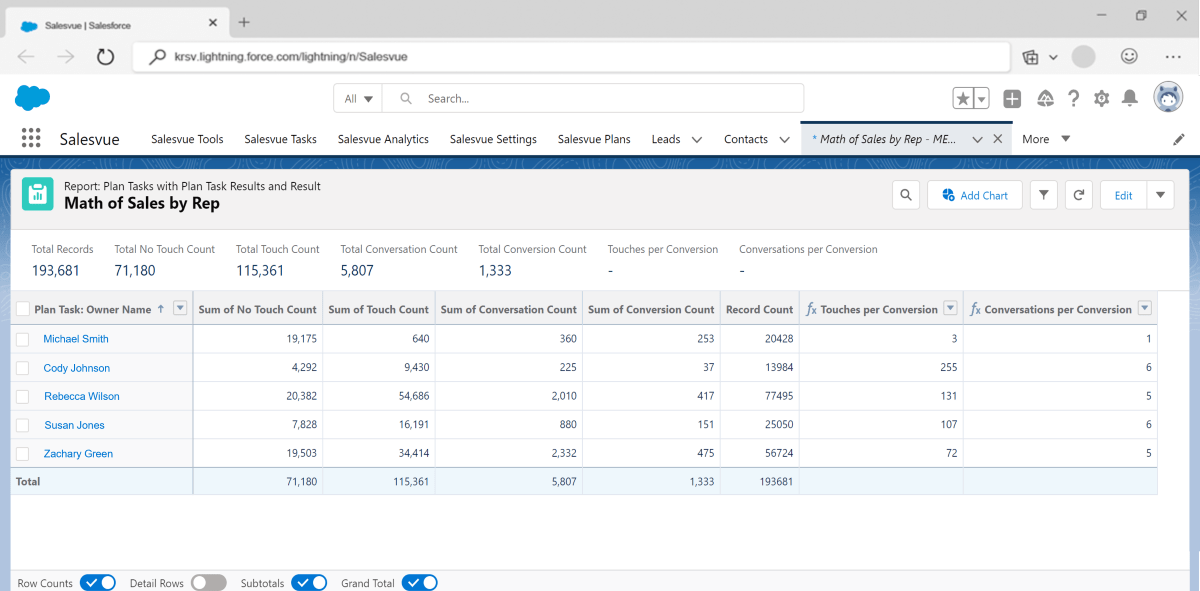Salesforce dominates the worldwide CRM market with a market share over double its nearest rival, SAP. And the winning platform is only expected to continue growing. Unfortunately, there is no shortage of sales teams who don’t use the CRM to its fullest extent, and worse, they use it inconsistently within their organizations. In this post, we’ll give you four simple Salesforce sales engagement rules that will help you help your team win more.
Rule 1: Don’t try to scale your best performers—it’s too hard. Instead, leverage their winning behaviors.
 We all have legends in our sales organizations about a “G.O.A.T” (Greatest of All Time). And you may have found yourself saying at one time or another, “if I had ten more reps just like the G.O.A.T, we’d be crushing it.”
Trying to replicate your top-performing sales reps isn’t viable unless you’ve got the right sales process, sales intelligence, sales communication, and sales software working effectively together.
Like you, almost every successful CRO or VP of Sales knows that sales engagement is all about the interactions between your customers and your sales team. But scaling Salesforce sales engagement using only Salesforce is nearly impossible.
You’ve probably heard stories (or have witnessed firsthand) larger sales teams using Salesforce and ending up with 100 different ways of adding a contact to the database. If contacts are not being added uniformly across the organization, it’s likely that your most effective messaging (that actually helps close deals) is all over the place as well.
What almost every successful VP of Sales knows is that the top-performing sales reps are paying close attention to how your prospects are engaging with different pieces of information and then using it to listen and shape a buying experience that will improve prospect value perceptions enough to get the deal done. To get it done, you need the right tools, ones that are Salesforce-native.
We all have legends in our sales organizations about a “G.O.A.T” (Greatest of All Time). And you may have found yourself saying at one time or another, “if I had ten more reps just like the G.O.A.T, we’d be crushing it.”
Trying to replicate your top-performing sales reps isn’t viable unless you’ve got the right sales process, sales intelligence, sales communication, and sales software working effectively together.
Like you, almost every successful CRO or VP of Sales knows that sales engagement is all about the interactions between your customers and your sales team. But scaling Salesforce sales engagement using only Salesforce is nearly impossible.
You’ve probably heard stories (or have witnessed firsthand) larger sales teams using Salesforce and ending up with 100 different ways of adding a contact to the database. If contacts are not being added uniformly across the organization, it’s likely that your most effective messaging (that actually helps close deals) is all over the place as well.
What almost every successful VP of Sales knows is that the top-performing sales reps are paying close attention to how your prospects are engaging with different pieces of information and then using it to listen and shape a buying experience that will improve prospect value perceptions enough to get the deal done. To get it done, you need the right tools, ones that are Salesforce-native.
Rule 2: Don’t overlook the power of native Salesforce sales engagement.
 Leveraging the best behaviors of your top performers starts with your analytics. You need to look at your G.O.A.T’s top-performing cadences, understand where other team members can leverage automation, and seamlessly connect prospect information with your communication tools.
Let’s face it. You can hire for great sales skills such as the ability to listen and empathize, demonstrate enthusiasm and confidence, and have insatiable curiosity, among other things. However, most often sales teams underperform because it’s not easy to scale the disciplined approach of your best performers.
A native Salesforce sales engagement platform changes all that by enabling your entire team of sales reps to improve sales communication by leveraging the highest impact content with your prospects.
Many sales engagement platforms claim to enhance existing workflows and bring the right tools together, but Salesvue is a native Salesforce sales engagement platform that allows you to run cadences for leads, contacts, accounts, AND opportunities.
Without a native Salesforce engagement platform, you’ll likely end up with fewer actionable insights to improve sales and marketing efforts, more redundancies, and the increased potential for security issues.
At this point, you might be thinking, “Wait a minute. You started this whole section with analytics, and our analytics today aren’t even that great.” It’s okay. With a Salesforce native sales engagement platform like Salesvue, your sales team won’t have to muddle through Salesforce any longer.
You’ll quickly have access to insights that will show you whether your reps are calling leads in a timely manner. You’ll know not only when a contact was added, but when it was assigned to a rep. Instead of your reps deciding who to call, when, and having 50 different ways for what your reps should be doing the same way, you’ll be focused on tracking time-to-touch and ensuring that they are using the best templates.
Leveraging the best behaviors of your top performers starts with your analytics. You need to look at your G.O.A.T’s top-performing cadences, understand where other team members can leverage automation, and seamlessly connect prospect information with your communication tools.
Let’s face it. You can hire for great sales skills such as the ability to listen and empathize, demonstrate enthusiasm and confidence, and have insatiable curiosity, among other things. However, most often sales teams underperform because it’s not easy to scale the disciplined approach of your best performers.
A native Salesforce sales engagement platform changes all that by enabling your entire team of sales reps to improve sales communication by leveraging the highest impact content with your prospects.
Many sales engagement platforms claim to enhance existing workflows and bring the right tools together, but Salesvue is a native Salesforce sales engagement platform that allows you to run cadences for leads, contacts, accounts, AND opportunities.
Without a native Salesforce engagement platform, you’ll likely end up with fewer actionable insights to improve sales and marketing efforts, more redundancies, and the increased potential for security issues.
At this point, you might be thinking, “Wait a minute. You started this whole section with analytics, and our analytics today aren’t even that great.” It’s okay. With a Salesforce native sales engagement platform like Salesvue, your sales team won’t have to muddle through Salesforce any longer.
You’ll quickly have access to insights that will show you whether your reps are calling leads in a timely manner. You’ll know not only when a contact was added, but when it was assigned to a rep. Instead of your reps deciding who to call, when, and having 50 different ways for what your reps should be doing the same way, you’ll be focused on tracking time-to-touch and ensuring that they are using the best templates.
Rule 3: Remote and virtual sales teams are easier to manage with scalable and repeatable processes that win the day.
 While VPs of software sales have been doing this for many years, many sales executives like you were just introduced to managing a virtual sales team in 2020.
Managing a high-performance sales team takes precision.
Your CRM, no matter how powerful it is, can quickly become a crowded database where your sales reps can lose focus and productivity.
The right Salesforce sales engagement platform will help your reps know where to begin their day and where they left off the previous day. The payoff is better prospecting and communication, and ultimately, more conversions.
It used to be that contact was king and content was queen. Now however, your best reps leverage the right message at the right time.
Today, you can scale those messages and make sure you’re helping all of your reps do what works most effectively. It’s not only about how many touches someone makes to a prospect, but it’s also about the message they provide.
The right message at the right time leads to down-funnel conversion.
One of the most difficult aspects of managing a sales team effectively is ramping up new reps. It’s a huge expense to train new employees. When systems and processes are easier to understand, you’re more likely to retain those employees, and you’ll get newer reps to full quota faster.
At the end of the day, it’s about more than scalable and repeatable processes. It’s also about ensuring sales and marketing are working as seamlessly as possible to improve overall performance.
Salesforce native sales engagement platforms like Salesvue provide the insights you need to easily see which marketing initiatives are providing the highest level of sales enablement impact.
While VPs of software sales have been doing this for many years, many sales executives like you were just introduced to managing a virtual sales team in 2020.
Managing a high-performance sales team takes precision.
Your CRM, no matter how powerful it is, can quickly become a crowded database where your sales reps can lose focus and productivity.
The right Salesforce sales engagement platform will help your reps know where to begin their day and where they left off the previous day. The payoff is better prospecting and communication, and ultimately, more conversions.
It used to be that contact was king and content was queen. Now however, your best reps leverage the right message at the right time.
Today, you can scale those messages and make sure you’re helping all of your reps do what works most effectively. It’s not only about how many touches someone makes to a prospect, but it’s also about the message they provide.
The right message at the right time leads to down-funnel conversion.
One of the most difficult aspects of managing a sales team effectively is ramping up new reps. It’s a huge expense to train new employees. When systems and processes are easier to understand, you’re more likely to retain those employees, and you’ll get newer reps to full quota faster.
At the end of the day, it’s about more than scalable and repeatable processes. It’s also about ensuring sales and marketing are working as seamlessly as possible to improve overall performance.
Salesforce native sales engagement platforms like Salesvue provide the insights you need to easily see which marketing initiatives are providing the highest level of sales enablement impact.
Rule 4: Security is not optional.
 Okay. Yes, there is more than one option when you’re looking for a Salesforce sales engagement platform. What’s not an option is your prospects’ and customers’ security. Not only does a native application provide a better experience for your reps and one less thing for them to learn, but it also creates the most secure infrastructure. Your data is always protected because you never leave the Salesforce instance.
You can start comparing platforms here. And you’ll quickly identify the real difference with the world’s first native Salesforce-native sales engagement platform.
So, what’s stopping your sales team from doing more, closing more, and improving more? Request a demo and let us know.
Okay. Yes, there is more than one option when you’re looking for a Salesforce sales engagement platform. What’s not an option is your prospects’ and customers’ security. Not only does a native application provide a better experience for your reps and one less thing for them to learn, but it also creates the most secure infrastructure. Your data is always protected because you never leave the Salesforce instance.
You can start comparing platforms here. And you’ll quickly identify the real difference with the world’s first native Salesforce-native sales engagement platform.
So, what’s stopping your sales team from doing more, closing more, and improving more? Request a demo and let us know.
Category
Tags
Subscribe to Funnel Vision
Get the latest and greatest right in your inbox




